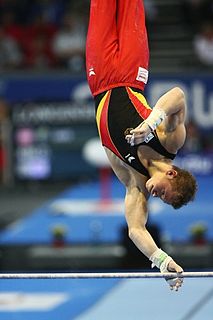 W
WThe balance beam is a rectangular artistic gymnastics apparatus, as well as the event performed using the apparatus. Both the apparatus and the event are sometimes simply referred to as "beam". The English abbreviation for the event in gymnastics scoring is BB. The beam is a small, thin beam which is typically raised from the floor on a leg or stand at both ends. The balance beam is only performed by female gymnasts. Beams are usually covered with leatherlike material, and are only 4 inches wide.
 W
WIn gymnastics, the floor refers to a specially prepared exercise surface, which is considered an apparatus. It is used by both male and female gymnasts. The event in gymnastics performed on floor is called floor exercise. The English abbreviation for the event in gymnastics scoring is FX.
 W
WThe horizontal bar, also known as the high bar, is an apparatus used by male gymnasts in artistic gymnastics. It traditionally consists of a cylindrical metal bar that is rigidly held above and parallel to the floor by a system of cables and stiff vertical supports. Gymnasts typically wear suede leather grips while performing on the bar. Current elite-level competition uses a more elastic fiberglass core rail similar in material to the rails used in the women's uneven bars and men's parallel bars apparatus.
 W
WParallel bars are floor apparatus consisting of two wooden bars slightly over 11 feet (340 cm) long and positioned at roughly hand height. Parallel bars are used in artistic gymnastics and also for physical therapy and home exercise. Gymnasts may optionally wear grips when performing a routine on the parallel bars, although this is uncommon.
 W
WThe pommel horse is an artistic gymnastics apparatus. Traditionally, it is used by only male gymnasts. Originally made of a metal frame with a wooden body and a leather cover, the modern pommel horse has a metal body covered with foam rubber and leather, with plastic handles.
 W
WThe rings, also known as steady rings or still rings, is an artistic gymnastics apparatus and the event that uses it. It is traditionally used only by male gymnasts, due to its extreme upper body strength requirements. Gymnasts typically wear ring grips while performing on the rings.
 W
WA springboard is a platform set upon one or usually multiple springs used in artistic gymnastics to propel a gymnast who jumps upon it further than if they had otherwise jumped off a fixed platform. The springboard is a vital part of the vault event, and is commonly used in some routines of other events, such as the balance beam, or uneven bars, to start the event by springing onto the apparatus. The springboard is usually about 2 feet (0.6 m) wide and 4 feet (1.2 m) long. The number of springs in a springboard depends on the gymnast.
 W
WThe uneven bars or asymmetric bars is an artistic gymnastics apparatus. It is made of a steel frame. The bars are made of fiberglass with wood coating, or less commonly wood. The English abbreviation for the event in gymnastics scoring is UB or AB, and the apparatus and event are often referred to simply as "bars". The bars are placed at different heights and widths, allowing the gymnast to transition from bar to bar. A gymnast usually adds white chalk to the hands so that they can grip the bar better.
 W
WThe vault is an artistic gymnastics apparatus which gymnasts perform on, as well as the skill performed using that apparatus. Vaulting is also the action of performing a vault. Both male and female gymnasts perform the vault. The English abbreviation for the event in gymnastics scoring is VT.